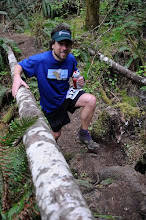According to the Western States participant guide one of the most commonly cited reasons for runners dropping out is trashed quads from all the downhills. With this in mind I set out to do repeats up the biggest climb in the MacDonald Forest McCollough Peak Oak Creek McCollough Peak 1:40 .
Saturdays McCollough Peak repeats
Needless to say I am not exactly thrilled to be living on the 3rd floor of my coop house today, but the run was great downhill training for Western States in June. I also found the true South Side Slip trail, which is basically a lower Lupine Letdown, and should not be confused with the South Ridge Trail higher up on the mountain. South Side Slip parallels a creek for most of its length, and is absolutely amazing. It’s definitely my new favorite trail in the Mac. After the four repeats, and with only an hour left the last time I got back to car/aid station, I opted for Face trail up to Bald Hill where I was treated to an amazing view of the Three Sisters and well defined nearby cumulus cloud with significant vertical growth. The last stretch up this way was a bit rough, but not unexpectedly so.
Looking down Face Trail at the town of Corvallis: eccentric contractions anyone?
All the same I am quite excited about how strong I felt all day yesterday. I think I managed about 9,000 ft cumulative elevation gain on the day, and significantly bumped up my number of cumulative summits of McCollough. I have in fact been keeping track of all my summits of the most prominent peaks and ridges in town as plotted below.
For those local runners interested in the nitty gritty, here is a table comparing each climb by mileage and elevation gain. Dimple Hill is via Dan’s trail starting at the bridge, Bald Hill via the backside prarie trail, McCollough is an average of many different routes from Oak Creek trailhead.
Comparison of Corvallis local climbs
Point of it all is this: I’m very happy to get be getting 8hr 40 mile long runs in this early in the year, and I’m very happy to be getting 50+ mile weeks in as well. My long runs so far this year have been 25, 30, 35, and 40 miles, all averaging about 175-250 calories per hour. All of these facts bode well for training for Western States, and hopefully as well for Chuckanut 50km, which is on 3/20. I am a little bit anxious about how slowly my speed is coming back to me, but given my intention to get in at least two 50 miles training runs, plus a few 60+ mile weeks before June, the speedwork will just have to wait.
Weekly mileage and long run mileage versus Week

















